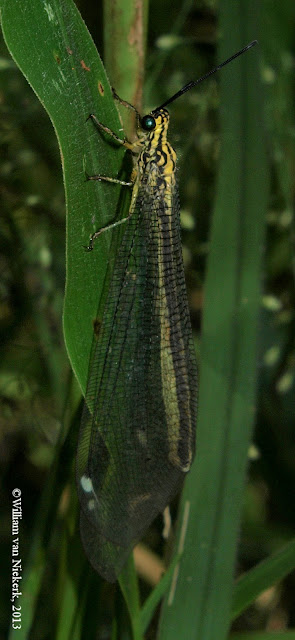Instead, today, we're going to explore the fourth major Superorder of the Endopterygota. We've introduced - elsewhere - wasps and co. (Hymenopterida), beetles and pals (Coleopterida) and flies et al. (including moths, scorpionflies and caddisflies, Panorpida). Any guesses as to whom the fourth group could comprise?
No?
Ah, well, you'll find out soon enough. Once more into the taxonomy!
We've already established that we're looking in Eukaryota-Animalia-Eumetazoa-Bilateralia-Nephrozoa-Protostomia-Ecdysozoa-Arthropoda-Hexapoda-Insecta-Dicondylia-Pterygota-Metapterygota-Neoptera-Eumetabola and Endopterygota.
So where to go from here?
Neuropterida, the superorder dominated by (and named for) the
Neuroptera, or lacewings. These are best known as small, pearly-green insects that flutter out of the grass around dusk in late summer, with species such as the (species complex) Chrysoperla carnea. We're going to leave them, and their suborder of Hemerobiiformia behind, and instead jump into the:
Myrmeleontiformia,
Myrmeleontoidea and the
Myrmeleontidae, the family most often referred to as the ant-lions. As a suborder, they are fairly universally distributed, but in Northern Europe, they are scarce to - over most of the UK - entirely absent.
Myrmelontinae
Mymeliontini and, taking a rare dive into the mysterious world of sub-tribes,
Myrmeleontina, where we find our genus and, within, the species:
Hagenomyia tristis
(Walker, 1853)
So let's meet it:
This lovely creature is also known as the Gregarious Antlion, largely because you very rarely see one on its own, but instead, walking through a drift of thick-leaved grasses in lightly shaded woodland, you'll disturb hundreds at once. This one and its companions seen in an orchard in Chongwe, Lusaka, Zambia, in February 2013.
As with most of their relatives, the young are subterranean predators with large jaws and mouthparts well designed for sucking the juice out of any insect small and unfortunate enough to be caught in their jaws. Adults of this family, despite their generally weak flight, are typically also predatory, with chewing mouthparts.
It is important to note that scale is everything here - they may be terrifying monsters to an unsuspecting mosquito or aphid, but to human beings they are completely harmless.
To put the above image in full body context, here's a more inclusive shot:
Images captured February 2013, in Chongwe Distr., Lusaka, Zambia, using an Olympus E-420, and all editing, cropping etc. done using GIMP 2.
.JPG)

No comments:
Post a Comment